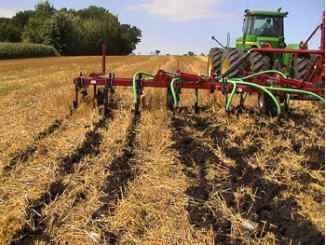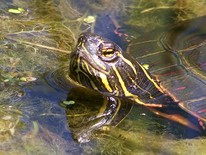 Grassed Waterway in June. Photo: Calumet County
The 2018 Land and Water Conservation Annual Report is now available on the Department of Agriculture, Trade and Consumer Protection website. This year’s report features over 15 counties and includes many maps and graphs of information about 2018 activities.
"From extreme flooding events to concerns about water quality, this past year underscored the importance of finding solutions to effectively address the broad spectrum of conservation challenges across Wisconsin. Through its stories, maps and photos, the 2018 Wisconsin Land and Water Annual Report highlights how Wisconsin’s conservation network works together to meet these challenges. This year’s report features over 15 counties and shares how their stories of education, innovation, partnerships, and site specific projects are all pieces of the conservation puzzle.
The benefits of effective conservation work are seen in environmental improvements on the land, and conservation actions create a ripple effect of benefit for our communities, businesses, farms, and citizens. It is through strong partnerships, dedicated professionals, and engaged farmers, landowners and residents that Wisconsin’s conservation partnership continues to make progress each year to improve and protect the health of our state’s soil and water resources."

A "Grazing Cover Crops" workshop will be held July 29th at the DNR South-central Service Center, 3911 S Fish Hatchery Rd, Fitchburg, WI 53711. This will be followed by two pasture walks at Highland Spring Farm: 12:00 PM - 1:30 PM, and Hook Lake Wildlife Area: 2:30 PM - 4:00 PM.
For more information:
The farming community is especially vulnerable to stress; ongoing economic conditions in agriculture are taking a toll on farm families and their rural communities according to Trisha Wagner, Farm Management Program Outreach Director, University of Wisconsin-Madison-Extension.
“Understanding stress and how chronic stress impacts all aspects of life and then learning how to manage stress are essential for one’s health and our rural communities,” said Wagner.
Extension resources, available online at https://fyi.extension.wisc.edu/farmstress/, help farmers, families, businesses and communities remain resilient by learning how to manage stress by recognizing and working to positively address, not avoid, the causes of stress. Resources include planning tools to make sound decisions and create a road-map for the future.
Many fields in Wisconsin were too wet this spring for timely planting of an intended commodity or feed crop. As these fields dry out, consider planting a cover crop. Quickly defined, a cover crop is established for benefits to the soil, cropping system, and environment; no biomass is harvested. Establishing a cover crop on these “prevented plant” acres will reduce soil erosion and weed growth, add soil organic matter (carbon) and enhance soil health. An actively growing and managed cover crop will also prevent yield reduction in the following year’s crop due to “fallow syndrome”. Read more...
The U.S. Department of Agriculture Natural Resources Conservation Service (NRCS) in Wisconsin has announced the schedule for 2019 Local Working Group (LWG) meetings. Eighteen meetings will be held across Wisconsin in August and September to gather input and help set priorities for U.S. Department of Agriculture conservation programs under the 2018 Farm Bill
USDA’s Natural Resources Conservation Service (NRCS) and the University of California at Davis Soil Resource Laboratory today announced the release of the iOS and Android SoilWeb app, version 2.0. The app now has a cleaner and more modern interface with GPS-location-based links to access detailed digital soil survey data (SSURGO) published by the NRCS for most of the United States. The newly updated SoilWeb smartphone application is available as a free download on Google Play and Apple App Store.
|

(an excellent article on mussels)
The humble bivalves can clean polluted water and bump up diversity — but in dammed rivers and fouled watersheds, many species face extinction. With help, maybe they can save themselves. (full article)
"Spending most of their lives buried in streambeds, freshwater mussels can be easy to miss. You could wade across a dense bed of them without noticing. An observant snorkeler might see scattered shells and pairs of holes in the river bottom where the creatures’ siphons pierce the sediment.
Yet even though they’re hunkered out of sight, freshwater mussels shape ecosystems.
They funnel food downward, fueling life in the riverbed and clarifying water for other species. They help to mitigate nutrient pollution, a widespread problem that leads to dead zones in some waters."
The Southwest Wisconsin Groundwater and Geology Study (SWIGG) of Grant, Iowa, and Lafayette Counties completed its first objective this spring: to assess the extent of well contamination in the three counties. The second and final round of broad groundwater sampling was collected April 12-13, 2019. Samples were collected from 539 randomly-selected private wells, a different group than the first round of sampling that occurred in November 2018. Read more
The Challenges of Phosphorus Reduction, Invasive Species, and Climate Change
From 2012, and especially relevant this year, an in-depth article by WDNR Limnologist Gina D. LaLiberte. Gina holds a BS and MS from the University of Michigan. LaLiberte has worked on issues in algal taxonomy, ecology, and paleolimnology for the past nineteen years.
"Found in every aquatic system in Wisconsin, algae are important members of the food webs of our lakes and rivers. Using photosynthesis, algae make carbohydrates and oxygen from carbon dioxide and water. Algae (and their carbohydrates) are eaten by zooplankton, insects, snails, and the many other organisms that serve as the base of all aquatic food webs. We can also thank algae for the air we breathe today, which contains oxygen produced in part by algae. Algae require the nutrients phosphorus and nitrogen for growth, but when these nutrients are available in excess of their needs, populations can rapidly increase to nuisance levels in an algal bloom."...read more
|

'Wisconsin's most impressive garden dwellers - podcast'
Jamie Nack, UW Extension senior wildlife outreach specialist, talks about hummingbirds in Wisconsin.
- The hummingbird situation in Wisconsin
- The hummingbird’s unique characteristics
- Attracting the birds: How-to
- What do hummingbirds do at night?
- Ways we can help our pollinators
- Fun facts!
|

The Standards Oversight Council (SOC) oversees the collaborative process for developing and updating technical standards that protect Wisconsin's natural resources. A technical standard is a document that specifies minimum criteria for planning, design parameters, and operations and maintenance for a practice that provides a benefit to soil and water resources.
SOC conducts a Technical Standards Assessment every 2 years to evaluate its process and give technical experts greater opportunity to improve Wisconsin's technical standards. Your input will be used to prioritize which standards will be revised in the next 2 years, what revisions to make, and what training may be made available to you and your colleagues. The 14-question survey is now available: https://www.surveymonkey.com/r/SOC2019survey
Please participate in this survey by Wednesday, July 3, 2019. We'd like to reach as many as possible, so please also forward this survey to colleagues who may use technical standards, so they too have this opportunity to provide input. Please respond only once.
|

WDNR- Collection System Subclass Update
from the Wisconsin Wastewater Operators Association
Work began on building the new Collection System Study Guide and Exam in March of 2017. The team worked diligently at getting a finished study guide document ready for publication on the WDNR’s Website which was made available in August of 2018. As a reminder, if the treatment plant owns the sanitary sewer collection systems associated with it, then at least one person will need to be certified in the collection system subclass. Look for the certification requirement in your WPDES permit reissuance. For satellite sewerage collection systems, this certification will be voluntary. Stay tuned for publication on the WDNR’s website this summer!
|
|